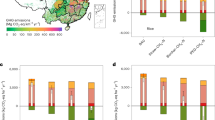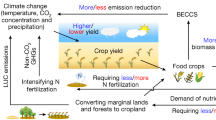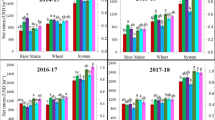Abstract
Agricultural bioenergy utilization relies on crop and livestock production, favouring an integrated crop–livestock–bioenergy production model. Yet the integrated system’s exact contribution to mitigating various environmental burdens from the crop production system and livestock production system remains unclear. Here we inventory the environmental impacts of each process in three subsystems at both national and regional scales in China, ultimately identifying key processes and impact categories. The co-benefits and trade-offs in nine impact categories are investigated by comparing the life cycle impacts in the background scenario (crop production system + livestock production system) and foreground scenario (integrated system). Freshwater eutrophication is the most serious impact category in both scenarios. Except terrestrial acidification, the mitigation effects on the other eight impact categories vary from 1.8% to 94.8%, attributed to fossil energy and chemical fertilizer offsets. Environmental trade-offs should be deliberated when expanding bioenergy utilization in the identified critical regions.
This is a preview of subscription content, access via your institution
Access options
Access Nature and 54 other Nature Portfolio journals
Get Nature+, our best-value online-access subscription
$29.99 / 30 days
cancel any time
Subscribe to this journal
Receive 12 digital issues and online access to articles
$119.00 per year
only $9.92 per issue
Buy this article
- Purchase on Springer Link
- Instant access to full article PDF
Prices may be subject to local taxes which are calculated during checkout







Similar content being viewed by others
Data availability
All the data used in this study are publicly available; see Supplementary Data and Supplementary Information for descriptions of the source data. Source data are provided with this paper.
Code availability
The custom code and algorithm used for this study are available in Methods and Supplementary Information.
References
Crippa, M. et al. Food systems are responsible for a third of global anthropogenic GHG emissions. Nat. Food 2, 198–209 (2021).
Gil, J. D. B. et al. Reconciling global sustainability targets and local action for food production and climate change mitigation. Glob. Environ. Change 59, 101983 (2019).
Clark, M. A. et al. Global food system emissions could preclude achieving the 1.5 °C and 2 °C climate change targets. Science 370, 705–708 (2020).
Bai, Z. H. et al. Nitrogen, phosphorus, and potassium flows through the manure management chain in China. Environ. Sci. Technol. 50, 13409–13418 (2016).
Usubiaga-Liano, A., Behrens, P. & Daiogloes, V. Energy use in the global food system. J. Ind. Ecol. 24, 830–840 (2020).
Hu, Y. et al. Food production in China requires intensified measures to be consistent with national and provincial environmental boundaries. Nat. Food 1, 572–582 (2020).
FAOSTAT. Food and agriculture data http://www.fao.org/faostat/en/ (2021).
Yu, C. et al. Managing nitrogen to restore water quality in China. Nature 567, 516–520 (2019).
Ma, L. et al. Exploring future food provision scenarios for China. Environ. Sci. Technol. 53, 1385–1393 (2019).
Rennie, T. J., Grant, B. B., Gordon, R. J., Smith, W. N. & VanderZaag, A. C. Regional climate influences manure temperature and methane emissions—a pan-Canadian modelling assessment. Sci. Total Environ. 750, 142278 (2021).
Bai, Z. H. et al. China’s livestock transition: driving forces, impacts, and consequences. Sci. Adv. 4, eaar8534 (2018).
Leip, A. et al. Impacts of European livestock production: nitrogen, sulphur, phosphorus and greenhouse gas emissions, land-use, water eutrophication and biodiversity. Environ. Res. Lett. 10, 115004 (2015).
Bai, Z. H. et al. Changes in pig production in China and their effects on nitrogen and phosphorus use and losses. Environ. Sci. Technol. 48, 12742–12749 (2014).
Wu, H. et al. The influence of crop and chemical fertilizer combinations on greenhouse gas emissions: a partial life-cycle assessment of fertilizer production and use in China. Resour. Conserv. Recycl. 168, 105303 (2021).
Prechsl, U. E. et al. Assessing the environmental impacts of cropping systems and cover crops: life cycle assessment of FAST, a long-term arable farming field experiment. Agric. Syst. 157, 39–50 (2017).
Jin, S. et al. Decoupling livestock and crop production at the household level in China. Nat. Sustain. 4, 48–55 (2021).
Ma, Y. et al. Cooperation between specialized livestock and crop farms can reduce environmental footprints and increase net profits in livestock production. J. Environ. Manag. 302, 113960 (2022).
Liu, B. & Rajagopal, D. Life-cycle energy and climate benefits of energy recovery from wastes and biomass residues in the United States. Nat. Energy 4, 700–708 (2019).
Kalt, G. et al. Greenhouse gas implications of mobilizing agricultural biomass for energy: a reassessment of global potentials in 2050 under different food-system pathways. Environ. Res. Lett. 15, 034066 (2020).
Zhang, L. B., Liu, Y. Q. & Hao, L. Contributions of open crop straw burning emissions to PM2.5 concentrations in China. Environ. Res. Lett. 11, 014014 (2016).
Song, J. N., Yang, W., Higano, Y. & Wang, X. E. Dynamic integrated assessment of bioenergy technologies for energy production utilizing agricultural residues: an input-output approach. Appl. Energy 158, 178–189 (2015).
Wang, B. et al. Selecting sustainable energy conversion technologies for agricultural residues: a fuzzy AHP-VIKOR based prioritization from life cycle perspective. Resour. Conserv. Recycl. 142, 78–87 (2019).
Khoshnevisan, B. et al. A critical review on livestock manure biorefinery technologies: sustainability, challenges, and future perspectives. Renew. Sust. Energ. Rev. 135, 110033 (2021).
Cavalli, D. et al. Nitrogen fertilizer replacement value of undigested liquid cattle manure and digestates. Eur. J. Agron. 73, 34–41 (2016).
Wang, X. E., Li, K. X., Song, J. N., Duan, H. Y. & Wang, S. Integrated assessment of straw utilization for energy production from views of regional energy, environmental and socioeconomic benefits. J. Clean Prod. 190, 787–798 (2018).
Hou, Y., Velthof, G. L., Lesschen, J. P., Staritsky, I. G. & Oenema, O. Nutrient recovery and emissions of ammonia, nitrous oxide, and methane from animal manure in Europe: effects of manure treatment technologies. Environ. Sci. Technol. 51, 375–383 (2017).
Xing, J. H., Song, J. N., Ren, J. Z., Yang, W. & Duan, H. Y. Regional integrative benefits of converting livestock excrements to energy in China: an elaborative assessment from life cycle perspective. J. Clean Prod. 275, 122470 (2020).
Aguirre-Villegas, H. A., Larson, R. & Reinemann, D. J. From waste-to-worth: energy, emissions, and nutrient implications of manure processing pathways. Biofuels, Bioprod. Bioref. 8, 770–793 (2014).
Zhang, Y. Z. et al. Environmental sustainability assessment of pig manure mono- and co-digestion and dynamic land application of the digestate. Renew. Sust. Energ. Rev. 137, 110476 (2021).
Humpenoder, F. et al. Large-scale bioenergy production: how to resolve sustainability trade-offs? Environ. Res. Lett. 13, 024011 (2018).
Acosta-Michlik, L., Lucht, W., Bondeau, A. & Beringer, T. Integrated assessment of sustainability trade-offs and pathways for global bioenergy production: framing a novel hybrid approach. Renew. Sust. Energ. Rev. 15, 2791–2809 (2011).
Acosta, L. A. et al. Sustainability trade-offs in bioenergy development in the Philippines: an application of conjoint analysis. Biomass Bioenerg. 64, 20–41 (2014).
Mouratiadou, I. et al. Sustainable intensification of crop residue exploitation for bioenergy: opportunities and challenges. GCB Bioenergy 12, 71–89 (2020).
Yang, L. et al. Shifting from fossil-based economy to bio-based economy: status quo, challenges, and prospects. Energy 228, 120533 (2021).
Zhu, Z. et al. Integrated livestock sector nitrogen pollution abatement measures could generate net benefits for human and ecosystem health in China. Nat. Food 3, 161–168 (2022).
Hitaj, C., Rehkamp, S., Canning, P. & Peters, C. J. Greenhouse gas emissions in the United States food system: current and healthy diet scenarios. Environ. Sci. Technol. 53, 5493–5503 (2019).
Laurent, A. et al. Methodological review and detailed guidance for the life cycle interpretation phase. J. Ind. Ecol. 24, 986–1003 (2020).
Tilman, D. & Clark, M. Global diets link environmental sustainability and human health. Nature 515, 518–522 (2014).
Rasmussen, L. V., Hall, C., Vansant, E. C., den Braber, B. & Olesen, R. S. Rethinking the approach of a global shift toward plant-based diets. One Earth 4, 1201–1204 (2021).
Davis, K. F., Rulli, M. C., Seveso, A. & D’Odorico, P. Increased food production and reduced water use through optimized crop distribution. Nat. Geosci. 10, 919–924 (2017).
Nicholson, F. et al. Nitrogen losses to the environment following food-based digestate and compost applications to agricultural land. Environ. Pollut. 228, 504–516 (2017).
Shu, K. S., Schneider, U. A. & Scheffran, J. Optimizing the bioenergy industry infrastructure: transportation networks and bioenergy plant locations. Appl. Energy 192, 247–261 (2017).
Wei, S. et al. Psychrophilic anaerobic co-digestion of highland barley straw with two animal manures at high altitude for enhancing biogas production. Energy Convers. Manag. 88, 40–48 (2014).
Wang, Y., Wu, X. H., Tong, X. G., Li, T. T. & Wu, F. Q. Life cycle assessment of large-scale and household biogas plants in northwest China. J. Clean Prod. 192, 221–235 (2018).
West, P. C. et al. Leverage points for improving global food security and the environment. Science 345, 325–328 (2014).
Strzalka, R., Schneider, D. & Eicker, U. Current status of bioenergy technologies in Germany. Renew. Sust. Energ. Rev. 72, 801–820 (2017).
Nicholson, F. A., Bhogal, A., Rollett, A., Taylor, M. & Williams, J. R. Precision application techniques reduce ammonia emissions following food-based digestate applications to grassland. Nutr. Cycl. Agroecosys. 110, 151–159 (2018).
Zhao, B., Shuai, C., Hou, P., Qu, S. & Xu, M. Estimation of unit process data for life cycle assessment using a decision tree-based approach. Environ. Sci. Technol. 55, 8439–8446 (2021).
Hu, Y. C. et al. Evaluating agricultural grey water footprint with modeled nitrogen emission data. Resour. Conserv. Recycl. 138, 64–73 (2018).
Liu, W. R. et al. Comparisons of pollution characteristics, emission situations, and mass loads for heavy metals in the manures of different livestock and poultry in China. Sci. Total Environ. 734, 139023 (2020).
Song, J. N., Li, K. X., Ren, J. Z., Yang, W. & Liu, X. Y. Holistic suitability for regional biomass power generation development in China: an application of matter-element extension model. J. Environ. Manag. 276, 111294 (2020).
Song, J., Yang, W., Higano, Y. & Wang, X. E. Modeling the development and utilization of bioenergy and exploring the environmental economic benefits. Energy Convers. Manag. 103, 836–846 (2015).
Li, Y. Y., Jin, Y. Y., Borrion, A. & Li, H. L. Current status of food waste generation and management in China. Bioresour. Technol. 273, 654–665 (2019).
Xu, Z. C. et al. Assessing progress towards sustainable development over space and time. Nature 577, 74–78 (2020).
Cavalett, O. & Cherubini, F. Contribution of jet fuel from forest residues to multiple Sustainable Development Goals. Nat. Sustain. 1, 799–807 (2018).
Yang, Q. et al. Prospective contributions of biomass pyrolysis to China’s 2050 carbon reduction and renewable energy goals. Nat. Commun. 12, 1698 (2021).
Huang, B. J. et al. Building material use and associated environmental impacts in China 2000-2015. Environ. Sci. Technol. 52, 14006–14014 (2018).
Zhao, H. et al. Comparative life cycle assessment of emergency disposal scenarios for medical waste during the COVID-19 pandemic in China. Waste Manag. 126, 388–399 (2021).
Liang, S. et al. Quantifying the urban food-energy-water nexus: the case of the Detroit metropolitan area. Environ. Sci. Technol. 53, 779–788 (2019).
Bai, Y. Y. et al. Water footprint coupled economic impact assessment for maize production in China. Sci. Total Environ. 752, 141963 (2021).
Huijbregts, M. A. J. et al. ReCiPe2016: a harmonised life cycle impact assessment method at midpoint and endpoint level. Int. J. Life Cycle Assess. 22, 138–147 (2017).
ISO. ISO 14044: 2006 environmental management—life cycle assessment—requirements and guidelines https://www.iso.org/standard/38498.html (2016).
National Institute for Public Health and the Environment, Ministry of Health, Welfare and Sport, Netherlands. Normalization scores ReCiPe 2016 https://www.rivm.nl/en/documenten/normalization-scores-recipe-2016 (2020).
OpenLCA Nexus. Ecoinvent database https://nexus.openlca.org/database/ecoinvent (2021).
National Bureau of Statistics of the People’s Republic of China. China Statistical Yearbook on Agriculture (China Statistics Press, Beijing, 2020).
National Development and Reform Commission of the People’s Republic of China. National Cost Benefit Compilation of Agricultural Products (China Statistics Press, Beijing, 2021).
Ministry of Ecology and Environment of the People’s Republic of China. National guideline for the compilation of emission inventory of atmospheric ammonia sources http://www.mee.gov.cn/gkml/hbb/bgg/201408/t20140828_288364.htm (2014).
IPCC. The emission factor database https://www.ipcc-nggip.iges.or.jp/EFDB/main.php (2021).
Cao, C. J. et al. Incorporating health co-benefits into regional carbon emission reduction policy making: a case study of China’s power sector. Appl. Energy 253, 113498 (2019).
Wang, M. et al. Hotspots for nitrogen and phosphorus losses from food production in China: a county-scale analysis. Environ. Sci. Technol. 52, 5782–5791 (2018).
Gu, B. J., Ju, X. T., Chang, J., Ge, Y. & Vitousek, P. M. Integrated reactive nitrogen budgets and future trends in China. Proc. Natl Acad. Sci. USA 112, 8792–8797 (2015).
Acknowledgements
This work was supported by the National Natural Science Foundation of China (no. 41801199) (J.S.) and grants from the Research Centre for Resources Engineering towards Carbon Neutrality (no. P0043023) and the Research Institute for Advanced Manufacturing, The Hong Kong Polytechnic University (no. P0041367) (J.R.).
Author information
Authors and Affiliations
Contributions
J.S. and W.Y. conceptualized and designed the study. J.X. and C.L. collected the original data, developed the life cycle datasets and compiled the figures. J.X., J.S., W.Y., H.D., H.Y. and J.R. interpreted the data and analysed the results. J.X. drafted the manuscript, and J.S., W.Y. and J.R. reviewed the manuscript and contributed to the revisions.
Corresponding authors
Ethics declarations
Competing interests
The authors declare no competing interests.
Peer review
Peer review information
Nature Food thanks Gerd Angelkorte and the other, anonymous, reviewer(s) for their contribution to the peer review of this work.
Additional information
Publisher’s note Springer Nature remains neutral with regard to jurisdictional claims in published maps and institutional affiliations.
Supplementary information
Supplementary Information
Supplementary methods, data descriptions, Figs. 1–7, Tables 1–32 and references.
Supplementary Data 1
Supplementary data on life cycle inventory of GHGs and pollutants of crop production and livestock production at provincial scale in China (2019).
Source data
Source Data Fig. 2
Source data from results to generate the bar charts in Fig. 2.
Source Data Fig. 3
Source data from results to generate the dot plots in Fig. 3.
Source Data Fig. 4
Source data from results to generate the Sankey diagrams in Fig. 4.
Source Data Fig. 5
Source data from results to generate the maps in Fig. 5.
Source Data Fig. 6
Source data from results to generate the bar charts in Fig. 6.
Source Data Fig. 7
Source data from results to generate the heat map in Fig. 7.
Rights and permissions
Springer Nature or its licensor (e.g. a society or other partner) holds exclusive rights to this article under a publishing agreement with the author(s) or other rightsholder(s); author self-archiving of the accepted manuscript version of this article is solely governed by the terms of such publishing agreement and applicable law.
About this article
Cite this article
Xing, J., Song, J., Liu, C. et al. Integrated crop–livestock–bioenergy system brings co-benefits and trade-offs in mitigating the environmental impacts of Chinese agriculture. Nat Food 3, 1052–1064 (2022). https://doi.org/10.1038/s43016-022-00649-x
Received:
Accepted:
Published:
Issue Date:
DOI: https://doi.org/10.1038/s43016-022-00649-x



